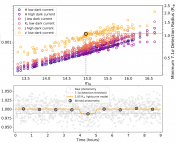Title: An astrometric planetary companion candidate to the M9 Dwarf TVLM 513−46546
Authors: Salvador Curiel, Gisela N. Ortiz-León, Amy J. Mioduszewski, Rosa M. Torres
First Author’s Institution: Instituto de Astronomía, Universidad Nacional Autónoma de México (UNAM), Apdo Postal 70-264, México, D.F., México
Status: Accepted for publication in The Astronomical Journal, open access on arXiv
Finding Planets
Since the first detections of planets outside of our solar system in the 1990s (for a review see this link), the exoplanet field has quickly grown. Initially, exoplanet detections were dominated by searches for Doppler shifts in the spectra of bright stars caused by the gravitational pull of one of more planets (known as the radial velocity method). In the last decade however, space-based satellites such as Kepler and TESS have shifted the focus to the transit method, or searching for small dips in the light received from stars as planets pass in front of them.
However, these are not the only methods we can use to find planets. Astronomers have also made use of the light-bending power of gravity (known as microlensing) to find planets, which is a major science goal of the upcoming Nancy Grace Roman Space Telescope. Sometimes, it is even possible to directly image a planet if the light of the host star can be blocked. Combined, these various methods have allowed us to find more than 4000 exoplanets orbiting stars other than our Sun.
Wobbly Stars
There is one exoplanet detection method that we haven’t discussed yet, known as the astrometric method. This method essentially looks at the position of a star over a period of time and tracks deviations from the expected position. Discovering a planet this way requires excellent precision though. Fortunately the Gaia satellite is capable of making such a measurement, and it is expected that by the end of the mission that we will find many new planets through this method (for more details see this bite). With that said, there is only one currently claimed discovery of an exoplanet through astrometry. Today’s paper increases that count to two!
M-dwarfs, stars cooler than our Sun, are one of the major targets for exoplanet searches due to their large numbers in our Galaxy and the fact that habitable exoplanets around M-dwarfs are some of the best candidates for atmospheric characterization. In this paper, the authors look at the M9 dwarf TVLM 513 (with M = 0.06 – 0.08 solar masses), which had been a target for earlier studies in the radio using VLBI (very-long-baseline interferometry). The authors combine archival VLBI data with new observations to produce the stellar motions shown in Figure 1.

In Figure 1, there are two clear types of motion of TVLM 513. The first is the general motion from the upper left to the bottom right, caused by the proper motion of the star on the sky. The second is a back-and-forth motion known as parallax, which is caused by the Earth’s orbit around the Sun. At first glance, the observed positions of the star appear to follow these two general trends well, but there are small deviations from this path that are shown in the bottom two panels of Figure 1. This tells the authors that there is something tugging on their star, which in this case turns out to be a planet!
From their fits to the observed astrometric signal, the authors find a companion at a period of P = 221 ± 5 days, with a circular orbit, a mass of m = 0.35−0.42 Jupiter masses, a semi-major axis of a = 0.28−0.31 au, and an inclination angle of i = 71−88° (where 0° is face-on and 90° is edge-on). This discovery, of the planet TVLM 513b, is only the second astrometric discovery of a planet to date. It is also the first planet detection to use radio astrometry.
TVLM 513b in Context
With a new (Saturn-like) planet in hand, the authors turn towards the wealth of exoplanet observations to understand how their exciting new discovery fits in with the broader picture. To do this, the authors create Figure 2, which compares the host stellar mass to the planetary mass and the semi-major axis of the planet’s orbit. In comparison to most known planets, TVLM 513b orbits a much lower mass star. While the TESS mission will begin to add new planets discovered around other low mass stars, astrometry will continue to be an effective method for finding planets around such stars. TVLM 513b itself is somewhat moderate in terms of its mass and semi-major axis compared to other planets. Combined, this system lies in a relatively unexplored region of parameter space. Most other planets in this region were found using microlensing, which unfortunately does not allow for detailed follow-up observations.

The authors also note that the parameters of this planet are somewhat unexpected given commonly-accepted theories of planet formation. The two main theories for the creation of giant planets are core accretion and disk instability. For core accretion, the masses of planets should scale with their host star, so a massive planet around such a low mass star is unexpected. While disk instability can create massive planets around low mass stars, both models predict massive planets to occur at least a few au from the central star, whereas TVLM 513b has a semi-major axis of ~0.3 au. The authors note that planet could have formed farther out and migrated in, but how, and why did it stop at 0.3 au?
In brief, the authors of today’s paper have found a new planet through radio astrometry. But their discovery amounts to more than that. It is further proof that astrometry can not only find planets, but prompt new questions that will continue to drive the exoplanet field forward. This planet, combined with the many that continued TESS and Gaia observations and future missions will yield will answer outstanding questions and ask even harder ones as well try to understand the origins of planetary systems both far away and closer to home.




